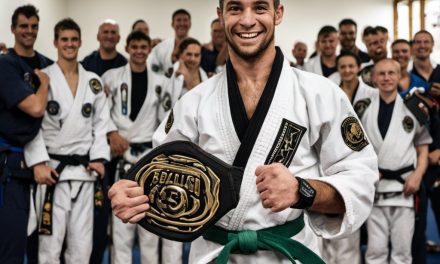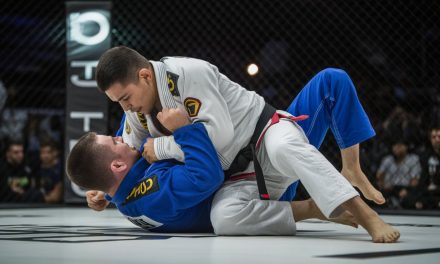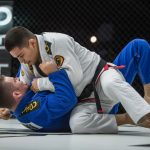How a simple partnership between Milan Police and a local BJJ gym is showing the world why every cop should train jiu-jitsu
KEY TAKEAWAYS
- Milan Police Department partners with J5 Brazilian Jiu-Jitsu in Grants, New Mexico, providing free training through the national “Adopt A Cop” program
- Training costs nothing to police departments – officers only need to commit their time
- The program focuses on control over force, helping officers handle situations without reaching for tasers or pepper spray first
- Benefits go beyond physical skills – training provides stress relief, confidence, and better decision-making under pressure
- J5 BJJ is the sixth gym in New Mexico certified to provide free training for police and first responders
- The program is open to all first responders including fire, dispatch, corrections, and state police
It all started with a kid learning jiu-jitsu. But what happened next might change how police officers across America handle dangerous situations.
Chief Carl Ustupski of the Milan Police Department was watching Joey Gonzales teach his son Carson some Brazilian Jiu-Jitsu moves at J5 Brazilian Jiu-Jitsu in Grants, New Mexico. That’s when it hit him like a lightning bolt.
“Man, that move right there could have saved us a use-of-force review two months ago,” Chief Ustupski thought to himself.
That simple moment sparked a partnership that’s now reshaping how local law enforcement trains for high-pressure encounters. The goal? Fewer injuries, less reliance on tasers and pepper spray, and way more confidence when things get physical.
Why This Matters More Than You Think
Here’s something that might shock you: most police officers get less than four hours of hands-on defensive tactics training per year. Think about that for a second. These are people who might need to physically control dangerous situations, but they get less training time than most BJJ practitioners get in a single week.
Chief Ustupski knows this problem firsthand. He went nearly a decade after the police academy without any defensive tactics training. “We’re expected to de-escalate dangerous situations, but most officers haven’t been trained to handle physical encounters without reaching for a tool,” he explained. “Tasers fail. OC spray fails. You’ve got to have more than just gadgets.”
That’s where Brazilian Jiu-Jitsu comes in like a game-changer.
The Science Behind Why BJJ Works for Cops
Research is backing up what practitioners have known for years – jiu-jitsu training makes law enforcement safer for everyone involved. Studies have shown some incredible results:
- Police departments with BJJ training programs have seen significant reductions in use of force incidents
- Officer injuries drop dramatically when officers know how to control situations on the ground
- Suspect injuries also decrease because officers can control without having to strike or use weapons
- Officer confidence increases, leading to calmer decision-making under pressure
Joey Gonzales, a former professional fighter who opened J5 Jiu-Jitsu, puts it perfectly: “It’s confidence. It’s discipline. It’s about being in control without having to hurt someone.”
How the “Adopt A Cop” Program Works
The partnership in Milan operates through the national “Adopt A Cop” program, which is pretty genius in how simple it is. Here’s how it works:
- Police officers train for free until they reach blue belt level
- Gyms volunteer to “adopt” officers and cover all training costs
- Officers just need to show up and train – no financial burden on departments
- The program is funded by donations and generous gym owners
J5 Brazilian Jiu-Jitsu became the sixth gym in New Mexico certified to provide this training. Chief Ustupski didn’t stop with just his department either. “We invited fire, dispatch, corrections, and state police,” he said. “We want everyone to benefit from this—not just physically, but mentally.”
More Than Just Fighting Skills
What makes this program special isn’t just the physical techniques. Gonzales sees the bigger picture: “A lot of officers and first responders are dealing with stress, burnout, and trauma. Training jiu-jitsu gives you purpose, progress, and peace of mind. And yes, you’ll sweat a lot too.”
Chief Ustupski agrees: “It’s therapy, it’s stress relief. And when your body’s trained, your brain is calmer under pressure.”
The benefits extend beyond the police station too. Gonzales trains kids with anti-bullying programs where they learn to “use their words first, then techniques only if absolutely necessary. The same idea applies to officers.”
Real Results from a White Belt Chief
Chief Ustupski admits he’s still early in his training – sporting a white belt with zero stripes. But he’s already seeing results. “We’re trying to prevent injuries, lawsuits, and deadly mistakes. This is a tool that could change everything.”
The chief’s honesty about being a beginner shows something important about this program – it’s not about creating super-warriors. It’s about giving officers basic skills that can make the difference between a situation going bad and everyone going home safe.
Building Stronger Communities Through BJJ
Gonzales has an even bigger vision than just training cops. “We’re trying to build confidence in kids, reduce violence in schools, and make this community stronger. When you walk with confidence, bullies leave you alone. When officers walk with skill, people stay safe.”
This approach matches what many BJJ practitioners know – the gentle art changes people from the inside out. It builds confidence, teaches respect, and shows that real strength comes from control, not aggression.
The Ego Check That Saves Lives
Perhaps the most important part of this whole program comes down to something every BJJ practitioner understands – checking your ego at the door.
“We just want this to be used,” Gonzales said about the program. “The door’s open. You just have to check your ego and step on the mat.”
For police officers, this ego check might be the most valuable lesson of all. Learning to be comfortable being uncomfortable, accepting that you don’t know everything, and understanding that real control comes from technique, not force – these are lessons that can literally save lives.
What This Means for the Future
The Milan Police Department’s partnership with J5 BJJ isn’t just a feel-good local story. It’s a blueprint that other departments across the country are starting to follow. As more research comes out showing the benefits of BJJ training for law enforcement, and as programs like “Adopt A Cop” make it financially feasible, we might be looking at the future of police training.
The best part? It’s already working. Officers are getting better training, communities are safer, and both sides are building the kind of respect that comes from understanding each other’s challenges.
Classes are now underway in Milan (exact training days aren’t shared publicly for safety reasons), and Gonzales encourages any first responder or interested officer to reach out. The door really is open – you just have to step on the mat.
As Chief Ustupski puts it: “This is a tool that could change everything.” For those of us who train BJJ, we’ve known that all along. Now the rest of the world is starting to catch up.
SOURCES
- Milan Police Turn to Jiu-Jitsu for Safer Policing | Cibola Citizen
- Adopt A Cop BJJ Official Website
- Is Brazilian jiujitsu making policing safer for everyone? – NewsNation
- BJJ for Police – Case Study – Gracie University
- The Impact of Brazilian Jiu-Jitsu Training on Police Officer Confidence in Use of Force Performance
- How police can add Jiu-Jitsu to use of force training – Police1
- Police Turn to Jiujitsu to Curb Use of Force, Boost Mental and Physical Health – U.S. News






